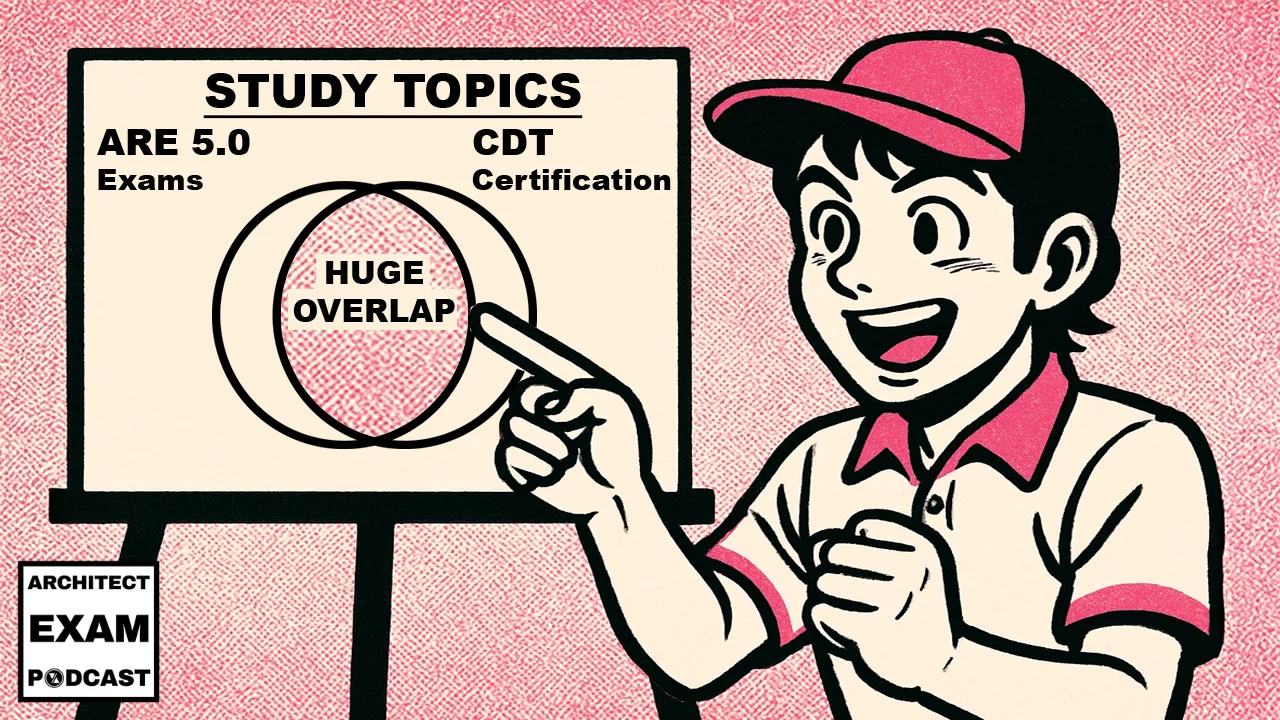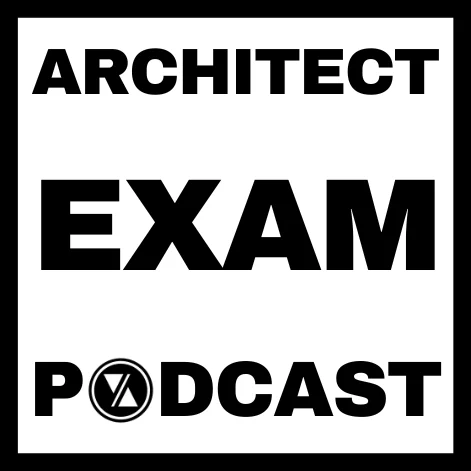Discover why CDT certification is becoming the strategic advantage for ARE candidates seeking to accelerate their licensing journey. This industry-recognized credential fills critical knowledge gaps, builds professional confidence, and provides the comprehensive project delivery understanding that architecture school often misses.
This podcast is also available on YouTube, Spotify, and Apple Podcasts
What is CDT Certification for ARE Candidates?
CDT stands for Construction Documents Technologist, a certification offered by the Construction Specifications Institute (CSI). But don’t let the name fool you – it’s not just about writing construction specifications.
The CDT covers the entire lifecycle of a construction project. This spans from when an owner first decides to build through programming, design phases, documentation, bidding, construction quality management, occupancy, and building removal.
CDT also covers project delivery methods, meaning what type of contract and team is needed for different project and client types (public, private, commercial, residential, etc.
Most importantly, it focuses on the roles, relationships, and responsibilities of every party involved in a project. This includes architects, engineers, contractors, owners, suppliers, and everyone who touches the building throughout its life. Knowing who is responsible for what makes your job expectations, and everyone else’s, crystal clear.
The Construction Industry Challenge
One of the construction industry’s biggest challenges is the lack of a comprehensive “handbook” for how projects move from concept to completion. Many professionals have to piece together this understanding through years of experience and on-the-job learning.
The CDT was specifically created to get everyone speaking the same language and following consistent standards. This leads to better project outcomes. The knowledge gained from this certification will be valuable on every single project throughout your career. This makes it almost a no-brainer investment in your professional development.
Many industry professionals believe anyone in the building industry should get this certification, and we agree! It’s not just for architects.
For ARE candidates specifically, it provides baseline knowledge that’s essential for effective communication and collaboration on every project. These skills will serve you throughout your career.
Curious about why ALL architecture professionals should pursue CDT certification? My detailed video explains how this credential benefits anyone who works in architecture or construction at any capacity, regardless of your licensure status or career intentions.
Benefits of CDT Certification for ARE Candidates
For ARE candidates specifically, the CDT certification offers several key advantages:
- Fills knowledge gaps not typically addressed in architecture school. Schools often focus heavily on schematic design while neglecting other critical project phases. The CDT provides ARE candidates with a comprehensive understanding of the entire project delivery process. It helps bridge the gap between the design world and when the project gets physically built.
- Creates a consistent framework for understanding project delivery. This gives you a structured approach and common vocabulary that standardizes processes across the industry. This shared understanding makes you immediately more effective when collaborating with different teams and disciplines. This is a huge help during the construction administration phase while you are answering RFIs, reviewing construction submittals, payment applications, and completing project closeout procedures.
- Builds confidence during your licensing journey. Many architects who have taken this certification report wanting to know even more. They bring that knowledge to job sites and interactions with consultants. This confidence boost can be invaluable for ARE candidates facing exam challenges.
- Develops product knowledge expertise that’s rarely taught in formal education. The CDT equips you with the knowledge to properly research, evaluate, and compare building products and materials. This skill helps when facing manufacturer marketing claims. This understanding helps you make more informed specification decisions and better communicate requirements to contractors.
- Connects you with professionals across the building industry. Many project managers, suppliers, and building representatives hold this certification. This expands your network beyond just architects – something particularly valuable early in your career.
CDT Certification vs. ARE Exams
While the ARE focuses primarily on testing an ARE candidate’s ability to protect public health, safety, and welfare, the CDT takes a broader view of the construction industry.
The good news for ARE candidates? There’s significant overlap. Studying for PCM, PjM, and CE covers about 80% of what you’ll need for the CDT.
The testing format is more straightforward too. The ARE uses complex scenarios requiring synthesis and decision-making. In contrast, the CDT focuses on clear understanding of concepts and relationships. Many ARE candidates find this refreshing.
The core study resource is “The Project Delivery Practice Guide.” It beautifully outlines every step of the project process.
Many experienced architects agree that this resource provides a comprehensive overview of project phases. They’ve never seen these phases so clearly articulated elsewhere – even in architecture school.
This resource alone provides ARE candidates with invaluable knowledge for both the CDT and their future practice.
Ideal Timing for ARE Candidates Taking the CDT Certification Exam
So when should you as an ARE candidate pursue the CDT?
The perfect scenario would be before starting your ARE journey. But I understand the priority is usually getting licensed first.
Many successful ARE candidates integrate CDT preparation while working through their AREs. I’ve seen ARE Bootcampers pass the CDT with just a few weeks of focused study. They pair this with what they’ve already learned for their ARE divisions. This makes it a manageable addition to your licensing journey.
A Success Story
One ARE Bootcamper shared that he took the CDT between his final two ARE divisions. After feeling beaten down by failed attempts, the CDT provided a confidence boost at a critical moment.
“The CDT was a breath of fresh air,” he told us. “I walked in, took the test, thought it was easy, and found out I passed. It blew me up and gave me the motivation to wrap up my architect exams.”
For many ARE candidates, this refreshing change of pace can be exactly what you need. It can break through mental barriers and reignite motivation for the final push toward licensure.
CDT Certification Exam Details & Next Steps for ARE Candidates
The CDT is offered twice a year – spring (May-June) and fall (November-December). For complete details and registration information, check the official CSI CDT certification page.
Unlike the ARE, you register months in advance. Costs increase as the testing window approaches. For ARE candidates already familiar with test scheduling, this difference is important for planning purposes.
Free Information Sessions
If you’re an ARE candidate interested in learning more, we offer free information sessions before each testing cycle. These sessions specifically address how CDT complements your licensure journey.
Emily and I typically host these FREE CDT Information Webinars each time CDT registration opens. Find details about our upcoming webinar or watch the recording from our last session at our CDT Information Webinar page.
CDT 101 Course
After seeing so many of our ARE Bootcampers pursue their CDT certification and consistently complain about the lack of quality study materials, we decided to take action. As seasoned veterans of creating effective ARE study resources, we developed CDT 101, a comprehensive course featuring practice questions, graphics, and interactive elements specifically designed to make CDT studying engaging and effective.
We created our course from scratch based on the testing criteria provided by CSI. This is the same approach we use for our ARE 101 courses. While many CDT courses presented by CSI chapters use standardized slides often presented by people who didn’t create the content, we built ours with the same diligence and attention to detail that’s made our ARE prep materials so effective.
Our practice questions are deliberately challenging – even harder than the actual exam – similar to our ARE prep approach, ensuring you’re well-prepared for test day! Every week my inbox fills with excited messages from ARE Bootcampers celebrating their CDT success.
Many ARE candidates find that pursuing CDT certification provides a refreshing change of pace from the intensity of ARE preparation.
Why CDT Certification Can Be a Welcome Break for ARE Candidates:
- Much of the content feels familiar if you’ve studied for PcM, PjM, and CE
- The straightforward testing format is refreshing after complex ARE scenarios
- Many candidates already know many answers before even studying
- It provides a rare “slam dunk” opportunity during your licensing journey
- The confidence boost can be invaluable for returning to ARE divisions
Additional resources for ARE candidates pursuing CDT certification:
- Visit CSI’s official CDT certification webpage
- Watch our video about why ALL architecture professionals should become CDT Certified
- Register for our free CDT Information Webinar
- Explore our comprehensive CDT 101 course
CDT Certification: A Worthy Investment for ARE Candidates
For ARE candidates, the CDT certification is more than just another credential – it’s a strategic investment in your professional development and a powerful complement to your licensing journey.
As a baseline of knowledge for everyone in the construction industry, it bridges gaps between design and execution that architecture school often misses.
Whether you’re midway through your ARE divisions or just starting to think about licensure, the CDT offers ARE candidates valuable perspective, a confidence boost, and a deeper understanding of how buildings come together from concept to completion.
It’s well worth considering as you build your career in architecture – and might just be the strategic advantage you need on your path to licensure.



